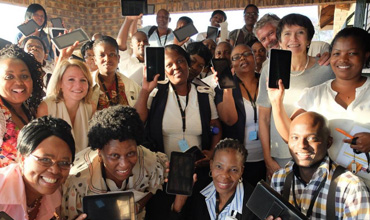References:
[1]. Adler,
R. B. (1995). Interplay: The Process of Interpersonal Communication. 6th Ed. Fort Worth: Harcourt Brace College Publishers.
[2]. Althen, G. (1983).
The Handbook of Foreign Student Advising. Chicago: Intercultural Press.
[3]. Anderson, J. A.
(1987). Communication Research: Issues and Methods. New York: McGraw-Hill Publishing
Company.
[4]. Aubel, J. (1994).
Guidelines for Group Studies Using the Group Interview Technique. Geneva, ILO.
[5]. Baker, M. J. (1998).
Macmillan Dictionary of Marketing and Advertising. 3rd Ed. London: Macmillan Press Ltd.
[6]. Banks, P. S. (1995).
Multicultural Public Relations: a Social-Interpretive Approach. USA.
[7]. Baran, S. J. (1999).
Introduction to Mass Communication. California: Mayfield Publishing Company
[8]. Beri, G. C. (1989).
Marketing Research. New Delhi: Tata McGraw-Hill Publishing Company Ltd.
[9]. Bormann, E. G.
(1980). Communication Theory. USA: Holt, Rinehart and Winston
[10]. Brooks et al.
(1996). News Reporting and Writing. 5thed. New York: St. Martin Press.
[11]. Chalfant, H.
P &Labeff, E. (1988). Understanding People and Social Life: Introduction to
Sociology. USA: West Publishing Company.
[12]. Civikly, J. M.
(1981). Contexts of Communication. New York: Holt, Rinehart, Winston.
[13]. Coker, D. A &
Burgoon, J. K. (1987) “The Nature of Conversational Involvement and Nonverbal Encoding
Patterns” in Human Communication Research. Vol No.4. Texas: Sage Publications, Summer.
[14]. Cook, D. A. (1971).
Interpersonal Perception. Great Britain.
[15]. Devito, J. A.
(1976). Communication: Concepts and Processes. New Jersey: Prentice Hall.
[16]. (1972) The
Interpersonal Book. 6thed. New York: Harper Collins Publishing.
[17]. Dodd, H. C. (1992).
Dynamics of Intercultural Communication. 3rd ed. USA: Brown Publishers.
[18]. Dupraw, M. E.
& M. Axner. “Toward a More Perfect Union in an Age of Diversity: Working on
Common Cross-Cultural Communication Challenges.” [On-line] URL: http://www.pbs.org/ampu/crosscult.html, 2000.12.07.
[19]. Ehrenhaus, P.
(1988) “Culture and the Attribution Process: Barriers to Effective Communication”
in Theories in Intercultural Communication. Edited by Young Y. Kim and William,
B. Gudykunst. California: Sage Publications.
[20]. Fiber, L. L.
& Smith, C. E. (1987). Toward Internationalism: Readings in Cross-Culture Communication.
2nd ed. USA: Newbury House Publishers.
[21]. Gathu, F. W.
(1995) Television and the Shaping of Culture in Kenya: a Case Study of Nairobi High
School Youth’s Use of Foreign TV Programming. Unpublished Doctorate Thesis, Graduate
College of Bowling Green State University, USA: Ohio.
[22]. Goffman, E. (1967).
Intercultural Ritual. USA: First Pantheon Books Edition.
[23]. Griffin, E. M.
(1997). A first Look at Communication Theory. 3rded. New York: The McGraw-Hill
Companies, Inc.
[24]. Grunlan, S. A.
& Marvin, K.M. Cultural Anthropology: a Christian Perspective. 2nd ed. Michigan: Zondervan Publishing House.
[25]. Gudykunst, W.
B. & Grumbs, L. I. (1983). “Social Cognition and Intergroup Communication” in
Handbook of International and Intercultural Communication. California: Sage Publication.
[26]. Gutek, G. L.
(1991). Cultural Foundations of Education: Bibliographical Introduction. USA: Macmillan
Publishing Company.
[27]. Holmes, A. F.
(1991). Shaping Character: Moral Education in the Christian College. Michigan: Eerdmans
Publishing Co.
[28]. Idoc Internationale
(1999). The Right to Communicate: a Duty to Particpate (99/1-2). Rome.
[29]. Inch, M. A. (1982).
Doing Theology across Cultures. Michigan: Baker Book House.
[30]. Infant, D. A.,
Rancer, A.S. & Womack, D.F (1993) Building Communication Theory. 2nd ed. Illinois: Waveland Press, Inc.
[31]. Jain, G. L. (1998)
Research Methodology: Methods, Tools and Techniques. New Delhi: Mangal Deep Publications.
[32]. Johnson, W. D.
&. Johnson, P. F. (1982). Joining Together: Group Theory and Group Skills. 2nd ed. USA: Prentice-Hall, Inc.
[33]. Kivy, B. (1998).
The Relationship between Public Commitment and Self-persuasion: a Case of Daystar
University’s Code of Conduct. Unpublished Master’s Thesis, Daystar University, Nairobi,
Kenya.
[34]. Kohls, L. R.
(1994). Developing Intercultural Awareness: a Cross-Cultural Training Handbook.
2nd ed. Yarmoutn: Intercultural
Press.
[35]. Kolstoe, R. H.
(1973). Introduction to Statistics for the Behavioral Sciences. Illinois: The Dorsey
Press.
[36]. Krueger, R. A.
(1988) Focus Groups: a Practical Guide for Applied Research. Newbury Park: Sage
Publications, Inc.
[37]. Leedy, P. (1993).
Practical Research: Planning and Design. 5th ed. USA: Prentice-Hall.
[38]. Leemon, T. A.
(1972). The Rites of Passage in a Student Culture: Anthropology and Education. USA:
Teachers College Press.
[39]. Lenfers, A. D.
(1997). “How to Evangelize Cultures and Enculturate Faith in Ethiopia Today” in
Faith and Cultures in Ethiopia. (Towards a Pastoral Approach to Culture: a Symposium).
Addis Ababa: Ethiopia Review of Cultures.
[40]. Levine, R. A.
& Campbell, D. T. (1972). Ethnocentrism: Theories of Conflict, Ethnic Attitudes
and Group Behavior. USA: John Willey & Sons Inc.
[41]. Loewen, A. J.
(1975). Culture and Human Values: Christian Intervention an Anthropological Perspective.
California: William Carey Library.
[42]. Maleche, N. M.
H. (1997). Interpersonal Communication in Counseling Departments in Nairobi. Unpublished
Master’s Thesis, Daystar University, Nairobi, Kenya.
[43]. Mbennah, E. D.
(1994). An Investigation of Source Credibility Factors Among a Select African Audience
using Semantic Differential Technique. Unpublished Master’s Thesis, Daystar University,
Nairobi, Kenya.
[44]. McQuail, D. (1994).
Mass Communication Theory. 3rd ed.
London: Sage Publications.
[45]. Merkoblatt. How
do we Perceive or Shape “Foreign” and “Native” Cultural Identities? Research on
Processes of Intercultural Dissociation, Mediation and Identity-Shaping [On-line]
URL: http://www.volkswagen-uftung.de/english/merkDrat/merkfund.html.2000.12.07
[46]. Miell, D. &
Dallos, R. (1996). Social Interactions and Personal Relationships. Great Britain:
Sage Publications Ltd.
[47]. Miller, A. (1992).
A Pre-Departure Cross Cultural Orientation Programme for Daystar University Students
Going on Exchange to Christian Colleges Consortium. Unpublished Master’s Thesis,
Daystar University, Nairobi, Kenya.
[48]. Myers, K. M.
(1974). Christian Confronts Culture: a Strategy for Cross-Cultural Evangelism. Michigan:
Zondervan Publishing House.
[49]. Myers, L. B.
(1999) Walking with the Poor: Principles and Practices of Transformational Development.
New York: Orbis Books.
[50]. Odetola, O. T.
& Ademola, A. (1985). Sociology: an Introductory African Text. London: MacMillan
Publishers Ltd.
[51]. Okigbo, C. (1995).
Media and Sustainable Development. Nairobi: African Council for Communication Education.
[52]. Paige, R. M.
(1993). Education for the Intercultural Experience. 2nd ed. USA: Intercultural Press, Inc.
[53]. Patton, R. B.
& K. Griffin, K. (1 Interpersonal Communication in Action: Basic text and Readings.
3rd ed. N981) New York: Harper
& Row, Pub., Inc.
[54]. Phillipart, M.
(1992). The African Church in the Communication Era: a Handbook of Source Texts
for Christian Communications in Africa. Nairobi St. Paul Publications, 1992.
[55]. Rubin, R. B.,
A. M. Rubin & Piel, L.J. (1990). Communication Research: Strategies and Sources.
2nd ed. Belmont, CA: Wadsworth
Publishing Company.
[56]. Samovar, A. L.
& Porter, E.R (1997). Intercultural Communication: a Reader. USA: Wadsworth
Publishing Company.
[57]. . (1988). Intercultural
Communication: a Reader. 5th ed.
California: Wadsworth Publishing Company.
[58]. Sarbaugh, L.
E. (1979). Intercultural Communication. New Jersey: Hayden Book Company.
[59]. Schermerhorn,
J. R., Tankard, W. J (1997). Communication Theories: Origins, Methods, and Uses
in Mass Media. 4th ed. USA:
Longman Publishers.
[60]. Singleton, R.
A. Jr., C. B. Straits., & M. M. Straits, M. M (1993). Approaches to Social Research.
2nd Ed. New York.
[61]. Smith, K. D.
(1984). Make Haste Slowly: developing Effective Cross-Cultural Communication. Portland:
Institute for International Christian Communication.
[62]. . (1992). Creating
Understanding: a Handbook for Christian Communication across Cultural Landscape.
Michigan: Zondervan Publishing House.
[63]. Sommer, B. &
Sommer, R. (1997) A Practical Guide to Behavioral Research: Tools and Techniques.
4th Ed. New York: Oxford University
Press.
[64]. Stempel, H. Guido.
& H. B. Westley. (1989). Research Methods in Mass Communication. 2nded.
New Jersey: Prentice-Hall.
[65]. Stewart, J. (1995).
Bridges not Walls. 6thed. New York: McGraw-Hill, Inc.
[66]. Swanson, L. Curriculum
Transformation: Intercultural Communication. [On-line] http://www.inform.umd.edu/diversityweb/leadersguide/CT/Course/swanson.html.07/12/2000.
[67]. Tafoya, D. (1983)
“The Roots of Conflict: a Theory and Typology,” in Intercultural Communication Theory:
Current Perspectives. Edited by William B. Gudykunst. California: Sage Publications.
[68]. Trenholm, S.
& Arthur, J (1999). Interpersonal Communication. 3rd ed. Belmont: Wadsworth Publishing Co.
[69]. Verderber, R.
F., & Verderber, K. S. (1992) Inter-Act: Using Interpersonal Communication Skills.
California: Wadsworth Publishing Co.
[70]. Wahlstrom, B.
J. (1992). Perspectives on Human Communication. Minnesota: Wm. C. Brown Publishers.
[71]. Watzalawick,
P. et al. (1967). Pragmatics of Human Communication: a Study of Interactional Patterns,
Pathologies, and Paradoxes. New York: Norton.
[72]. Wood, T. J. (1999).
Interpersonal Communication: Everyday Encounters. 2nd ed. Belmont, CA: Wadsworth Publishing Co.

 Assessing Domestic Violence in NigeriaAuthor: Kehinde Oluseyi MacaulayDOI: 10.21522/TIJAR.2014.03.02.Art001
Assessing Domestic Violence in NigeriaAuthor: Kehinde Oluseyi MacaulayDOI: 10.21522/TIJAR.2014.03.02.Art001 Evaluation on Awareness and Application of Statistical Process Control (SPC) among Health Practitioners of Rural Tanzania Health FacilitiesAuthor: Crescent Daniel OmbayDOI: 10.21522/TIJAR.2014.03.02.Art002
Evaluation on Awareness and Application of Statistical Process Control (SPC) among Health Practitioners of Rural Tanzania Health FacilitiesAuthor: Crescent Daniel OmbayDOI: 10.21522/TIJAR.2014.03.02.Art002 A Model for Measuring the Impact of Broadband Internet on Innovations at Institutions of Higher Learning in KenyaAuthor: Rajab Philip MuchiriDOI: 10.21522/TIJAR.2014.03.02.Art004
A Model for Measuring the Impact of Broadband Internet on Innovations at Institutions of Higher Learning in KenyaAuthor: Rajab Philip MuchiriDOI: 10.21522/TIJAR.2014.03.02.Art004 Neuro-V: An all in One Natural Supplement to Improve Nerve Regeneration, Increase Cognitive and Physical Performance and Effects on NeuroprotectionAuthor: Nicole C. HankDOI: 10.21522/TIJAR.2014.03.02.Art005
Neuro-V: An all in One Natural Supplement to Improve Nerve Regeneration, Increase Cognitive and Physical Performance and Effects on NeuroprotectionAuthor: Nicole C. HankDOI: 10.21522/TIJAR.2014.03.02.Art005 Enhanced Simplified Symmetric Key Encryption AlgorithmAuthor: Mahendra Kumar ShrivasDOI: 10.21522/TIJAR.2014.03.02.Art006
Enhanced Simplified Symmetric Key Encryption AlgorithmAuthor: Mahendra Kumar ShrivasDOI: 10.21522/TIJAR.2014.03.02.Art006 The Impact of Early Childhood Development Centres on Performance of Children in Early Primary SchoolAuthor: Byson Colyns SabolaDOI: 10.21522/TIJAR.2014.03.02.Art007
The Impact of Early Childhood Development Centres on Performance of Children in Early Primary SchoolAuthor: Byson Colyns SabolaDOI: 10.21522/TIJAR.2014.03.02.Art007 What can be the outcome if Technology is incorporated into the Education Aspect of the Patient and their Families for the Effective Management of their Health Care?Author: Andrea Alison PenistonDOI: 10.21522/TIJAR.2014.03.02.Art008
What can be the outcome if Technology is incorporated into the Education Aspect of the Patient and their Families for the Effective Management of their Health Care?Author: Andrea Alison PenistonDOI: 10.21522/TIJAR.2014.03.02.Art008 Knowledge and use of Information and Communications Technologies (ICTS) in Teaching and Learning among Teachers and Students of Schools of Nursing and Midwifery in Benue State, NigeriaAuthor: Emmanuel O ChukwuDOI: 10.21522/TIJAR.2014.03.02.Art009
Knowledge and use of Information and Communications Technologies (ICTS) in Teaching and Learning among Teachers and Students of Schools of Nursing and Midwifery in Benue State, NigeriaAuthor: Emmanuel O ChukwuDOI: 10.21522/TIJAR.2014.03.02.Art009 Harmonization of Thyroid Stimulating Hormone; an Alternative ApproachAuthor: Izza AbdulhafedhDOI: 10.21522/TIJAR.2014.03.02.Art003
Harmonization of Thyroid Stimulating Hormone; an Alternative ApproachAuthor: Izza AbdulhafedhDOI: 10.21522/TIJAR.2014.03.02.Art003 The Capacity of Maids Training Centres to Train House Maids for Infant Care in Lusaka, ZambiaAuthor: Agnes Mando BandaDOI: 10.21522/TIJAR.2014.03.02.Art010
The Capacity of Maids Training Centres to Train House Maids for Infant Care in Lusaka, ZambiaAuthor: Agnes Mando BandaDOI: 10.21522/TIJAR.2014.03.02.Art010 Disclosure and Non-Disclosure of HIV Positive Status to Partners among Pregnant Women at a Regional Hospital in SwazilandAuthor: Roger MaziyaDOI: 10.21522/TIJAR.2014.03.02.Art012
Disclosure and Non-Disclosure of HIV Positive Status to Partners among Pregnant Women at a Regional Hospital in SwazilandAuthor: Roger MaziyaDOI: 10.21522/TIJAR.2014.03.02.Art012 Anticolitis Activity of Myrobalan Powder via Regulating Colonic Enterochromaffin Cells and SerotoninAuthor: Shirish SharmaDOI: 10.21522/TIJAR.2014.03.02.Art013
Anticolitis Activity of Myrobalan Powder via Regulating Colonic Enterochromaffin Cells and SerotoninAuthor: Shirish SharmaDOI: 10.21522/TIJAR.2014.03.02.Art013 Knowledge and Attitude of Tutors on Active Teaching and Learning in Health-Training InstitutionsAuthor: Keren Carol DrateruDOI: 10.21522/TIJAR.2014.03.02.Art014
Knowledge and Attitude of Tutors on Active Teaching and Learning in Health-Training InstitutionsAuthor: Keren Carol DrateruDOI: 10.21522/TIJAR.2014.03.02.Art014 Virtualization of Infrastructure as a Service (IAAS): Redundancy Mechanism of the Controller Node in OpenStack Cloud Computing PlatformAuthor: Shahed MurshedDOI: 10.21522/TIJAR.2014.03.02.Art015
Virtualization of Infrastructure as a Service (IAAS): Redundancy Mechanism of the Controller Node in OpenStack Cloud Computing PlatformAuthor: Shahed MurshedDOI: 10.21522/TIJAR.2014.03.02.Art015 Deciding Pertinent Citations in Published Empirical ArticlesAuthor: Adeleke Victor AdedayoDOI: 10.21522/TIJAR.2014.03.02.Art016
Deciding Pertinent Citations in Published Empirical ArticlesAuthor: Adeleke Victor AdedayoDOI: 10.21522/TIJAR.2014.03.02.Art016 The Potency of Information Technology in addressing Learning Anxiety Disorder (LAD) using the E-learning Education FrameworkAuthor: Ikechukwu F. EzeugoDOI: 10.21522/TIJAR.2014.03.02.Art017
The Potency of Information Technology in addressing Learning Anxiety Disorder (LAD) using the E-learning Education FrameworkAuthor: Ikechukwu F. EzeugoDOI: 10.21522/TIJAR.2014.03.02.Art017 Characteristics of Human Interactions between Daystar University National and International Students: an Intercultural Communication PerspectiveAuthor: Henri Buregea Bin RwakendaDOI: 10.21522/TIJAR.2014.03.02.Art018
Characteristics of Human Interactions between Daystar University National and International Students: an Intercultural Communication PerspectiveAuthor: Henri Buregea Bin RwakendaDOI: 10.21522/TIJAR.2014.03.02.Art018 The Role of Broadband in Spurring Innovations in KenyaAuthor: Rajab Philip MuchiriDOI: 10.21522/TIJAR.2014.03.02.Art019
The Role of Broadband in Spurring Innovations in KenyaAuthor: Rajab Philip MuchiriDOI: 10.21522/TIJAR.2014.03.02.Art019 Level of Stress in Parents of the Mentally Retarded ChildrenAuthor: Rubina K BenjaminDOI: 10.21522/TIJAR.2014.03.02.Art020
Level of Stress in Parents of the Mentally Retarded ChildrenAuthor: Rubina K BenjaminDOI: 10.21522/TIJAR.2014.03.02.Art020

